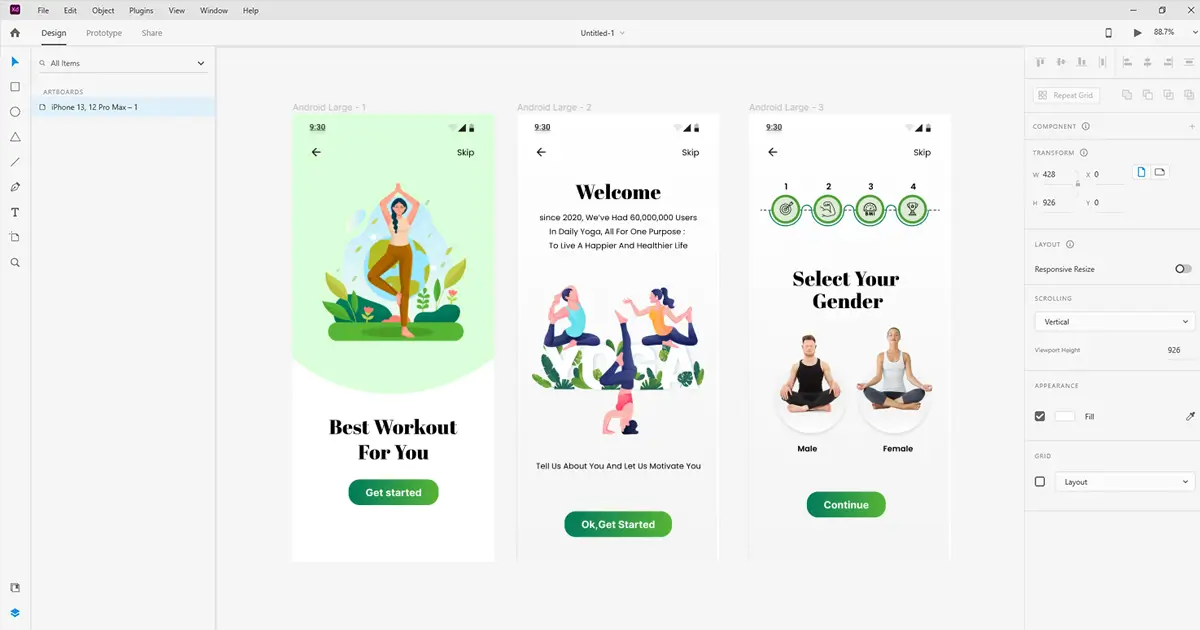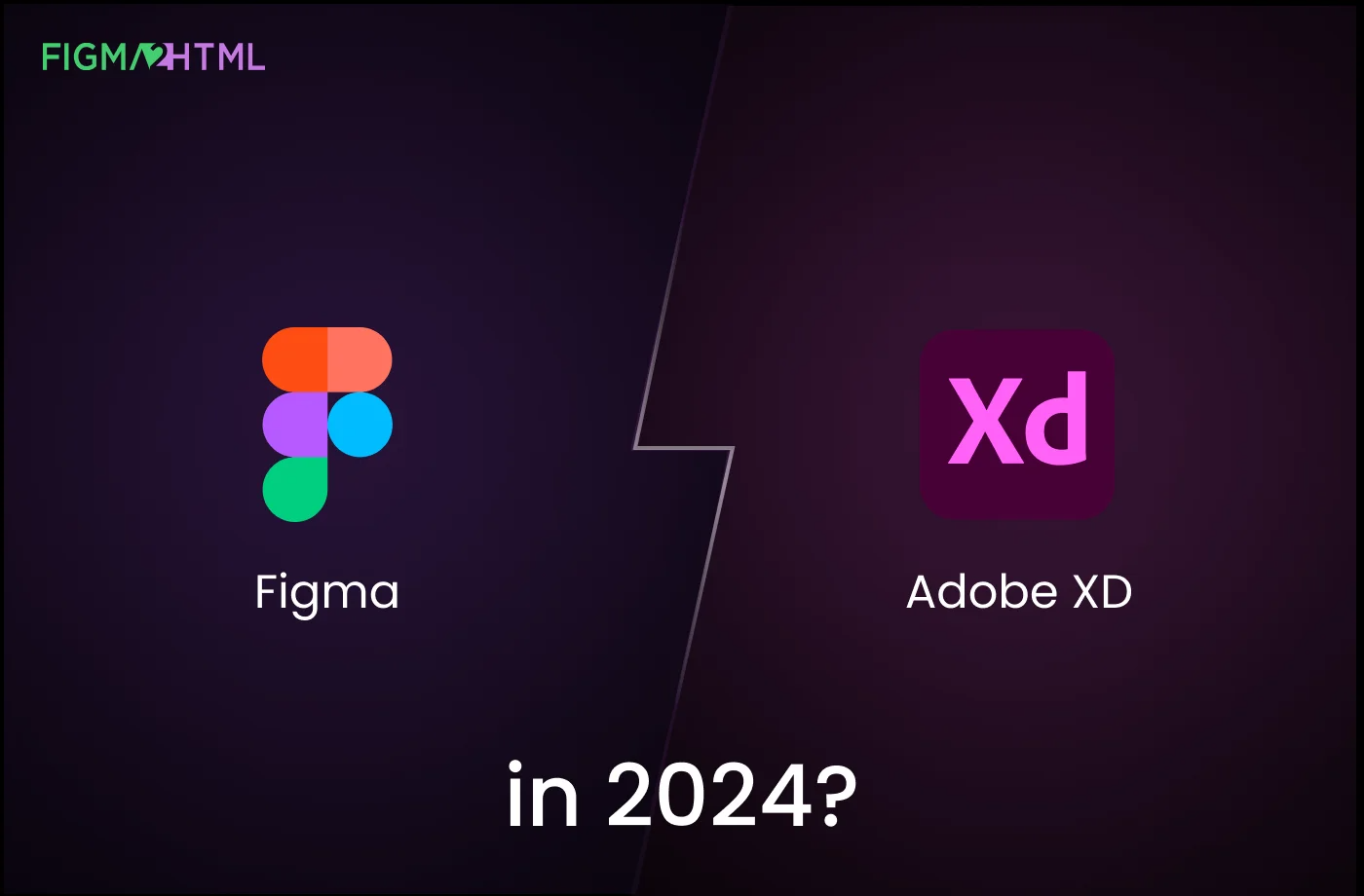We are Figma2html — a passionate and detail-oriented team of designers and developers. From UI/UX to fully functional websites, we craft quality digital experiences with a strong focus on communication, collaboration, and timely delivery. At the core of everything we do is a commitment to excellence and long-term client support.
Figma vs. Adobe XD: How to Choose Right Design Tool in 2024?
Choosing the right design tool is crucial for every UI/UX designer. In the realm of interface creation, two giants stand tall: Figma and Adobe XD
Both offer robust features, intuitive interfaces, and dedicated communities. But which one reigns supreme in the 2024 design landscape?
This comprehensive guide dives deep into the heart of Figma vs. Adobe XD, dissecting their key features, strengths, and weaknesses to help you make an informed decision.
Introduction to Figma and Adobe XD
Figma
Figma is a popular tool for designers because it lets teams work together on designs in real-time. It’s all online, so anyone can access it from anywhere. If you’re used to Sketch, Figma will feel familiar, and it works well across different devices.

Adobe XD
Adobe XD is part of Adobe’s Creative Cloud. It’s great for designing websites and apps, and it works seamlessly with other Adobe programs like Photoshop and Illustrator. It’s easy to use and has powerful features for making prototypes of your designs.

Let’s Understand the Comparison: Figma vs. Adobe XD
Collaboration
Figma: The champion of real-time collaboration. Multiple people can work on the same design simultaneously, seeing changes instantly. Perfect for teams!
Adobe XD: Offers collaboration features, but they’re not as seamless. Real-time editing isn’t available, and communication is less intuitive. Better for individual work or smaller teams.
Accessibility
Figma: Cloud-based, accessible from any device with an internet connection. Work anywhere, anytime!
Adobe XD: Desktop application for Windows and macOS. Offline work is possible, but some features require online access. Less flexible than Figma.
Pricing
Figma: Free plan with limited features, great for learning and individual projects. Paid plans for teams offer more features and collaboration tools.
Adobe XD: Part of the Adobe Creative Cloud subscription, requiring a monthly or annual fee. Includes access to other Adobe tools like Photoshop and Illustrator.
Design and Prototyping
Figma: Comprehensive set of design features, including vector editing, auto layout, and animation. Prototyping is straightforward and allows interactive prototypes.
Adobe XD: Similar design features to Figma, but some users prefer Figma’s vector editing and auto layout. XD shines in advanced prototyping with features like voice commands and microinteractions.
Plugins and Integrations
Figma: Boasts a huge library of plugins, extending its functionality and connecting with other tools seamlessly.
Adobe XD: Growing plugin library, but smaller than Figma’s. Integrates well with other Adobe tools, but limited with external platforms.
Learning Curve and Community
Figma: User-friendly interface and abundant resources make learning easy. Large and active community provides support and tutorials.
Adobe XD: Similar learning curve, but the interface might feel less intuitive. Smaller but growing community.
Future Considerations
Figma: Continuously evolving with new features and updates. Recent acquisitions by Adobe might raise concerns, but independent development is assured.
Adobe XD: Part of the established Adobe ecosystem, but updates might be slower than Figma’s rapid development.
Figma vs. Adobe XD: Features Showdown
Choosing between Figma and Adobe XD boils down to the features that best suit your design needs. Here’s a detailed comparison of their key features:
| Feature | Figma | Adobe XD |
|---|---|---|
| Vector Editing | Powerful, smooth and scalable | Strong, but some users prefer Figma’s flexiblity |
| Auto Layout | Automatic layout adjustments for responsive design | Responsive resize tool, but requires manual adjustments |
| Design Systems | Create and manage reusable components and styles | Similar, but Figma’s library management might be easier |
| Text & Typography | Advanced text options and extensive font library | Comprehensive text features and good font library |
| Animation & Microinteractions | Basic animation capabilities | Advanced animation and microinteraction features |
| Plugins & Integrations | Extensive library, connects with various tools | Growing library, good integration with Adobe tools |
| Learning Curve | User-friendly interface, large community for support | Similar learning curve, smaller community |
| Pricing | Free plan with limited features, paid plans for teams | Part of Adobe Creative Cloud subscription |
Which is Better for 2024?
Deciding between Figma and Adobe XD depends on what you need and what you’re comfortable with. Here’s a simple guide to help you choose:
Choose Figma if:
You work with a team and need to collaborate in real-time.
You use different devices and want a design tool that works well on all of them.
You like the idea of storing your designs in the cloud.
You want access to lots of extra tools and features through plugins.
Choose Adobe XD if:
You’re already using other Adobe programs like Photoshop or Illustrator.
You need advanced features for making interactive prototypes.
You want everything to work seamlessly together with other Adobe software.
You prefer a design interface that feels familiar, like other Adobe programs.
So, think about what matters most to you and your work, and that will help you pick the right one for you!
Conclusion
Figma wins with real-time editing and a free plan. Great for teams and budget-conscious users.
Adobe XD shines with advanced features and micro-interactions. Ideal for high-fidelity prototypes and Adobe lovers.
Remember:
The best tool depends on your needs. Try both and choose your design weapon!




